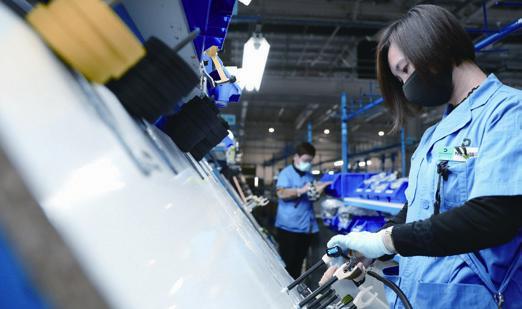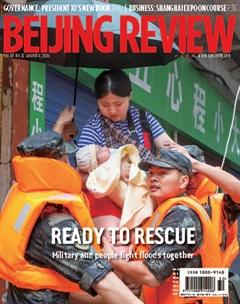Signs of Recovery
By Wang Jun
Saravoot Yoovidhya has several attachments to China. The CEO of Thailands TCP Group, a major player in the energy drink market, says Hainan in southernmost China is his familys ancestral home. Also, China is the largest market for his companys products and to nurture the potential, TCP is building a manufacturing plant in Beijing that will become operational next year. In the next three years, the group will invest over $150 million in China to grow its market share and launch new products for its global portfolio, creating local jobs in the process.
The TCP Group is among several foreign investors whose faith in the Chinese market has been buoyed by the resumption of production and normal life while other investment destinations in Europe and the United States still remain uncertain due to unchecked spread of the novel coronavirus.
The new Foreign Investment Law came into effect in China on January 1. In addition, new reforms like scrapping the cap on the shares foreign investors can hold in certain joint ventures and a new negative list in July that has further reduced the sectors off-limits for foreign investors from 40 to 33 have combined to make China retain its luster for overseas capital.
Against this backdrop, despite transnational investment having been hit hard globally, according to figures released by the Ministry of Commerce (MOFCOM), Chinas foreign trade and foreign direct investment (FDI) have stabilized. Paid-in foreign capital in June reached 117 billion yuan ($16.72 billion), up 7.1 percent year on year. It signified positive growth for three months in a row and much better performance in the second quarter of the year than in the fi rst.
From January to June, the utilized capital totaled 472.18 billion yuan ($67.55 billion). Though a year-on-year decrease of 1.3 percent, it was 9.5 percentage points lower than the decrease in the fi rst quarter. In the second quarter, FDI infl ows surged 8.4 percent year on year.
“China has continued to advance investment facilitation, issued a series of policies and measures to ensure stable foreign investment, and enlarged market access for foreign investors, all of which have produced positive effects,” Sang Baichuan, Director of the Institute of International Economy at the Beijingbased University of International Business and Economics, told China Business Journal. “China leads the world in resumption of work and production, underscoring the safety and stability of investment and unleashing a great amount of liquidity. Foreign investors will fi nd that China is one of the best destinations for investment.”
Recovery factors
He Manqing, Director of the Foreign Investment Research Institute of the Chinese Academy of International Trade and Economic Cooperation, said the rapid recovery of foreign investment can be attributed to three reasons: the Chinese economy remains promising with its steady recovery; effective control of the novel coronavirus attracted various resources into the Chinese market, enhancing the confi dence of foreign investors; and fi nally, the policies issued by the government to ensure stable foreign investment and trade, such as significantly reducing the negative list and giving pilot free trade zones (FTZs) more power to reform and opening up.According to figures from the National Bureau of Statistics, in the second quarter, the economy reversed the negative growth of 6.8 percent in the fi rst quarter to register a positive growth of 3.2 percent.
Gao Feng, MOFCOM spokesperson, said at an online press conference on July 16 that in the first half this year, foreign investment performed better than expected, and foreign investors expectations and confidence have been improving.
The 10-member ASEAN has become Chinas biggest trading partner, overtaking the U.S. and the EU, as well as becoming the key driver for FDI. In the fi rst half, investment from ASEAN expanded by 2.9 percent over the same period a year ago. Singapore alone invested 7.8 percent more. Other countries participating in the Belt and Road Initiative were another stimulus, with their collective FDI in the same period expanding by 5.9 percent.
Despite the tensions with the U.S. Government, investment from the U.S. grew by 6 percent in the fi rst half. “The U.S. is pushing its overseas investment back home, but the spread of the coronavirus in the country has made its investors panic and look for new investment opportunities,” Sang said.
He also said that while the U.S. decreased 32.9 percent year on year during the second quarter, China has achieved the worlds highest growth in that period, which will make“foreign investors be more optimistic about the prospects of the Chinese economy.”
An attractive destination
“While global investment opportunities are shrinking, China has furthered its opening up and cut the negative lists, which will create more opportunities for global investors,” Liu Xuezhi, a senior researcher with the Financial Research Center of Bank of Communications, told Financial News. “This will not only help China attract more high-quality foreign investment, but also contribute to global economic recovery.”Besides the national negative list, a second one for FTZs has cut the restricted sectors from 37 to 30.
Looking ahead to the second half, Liu forecast that since China has been the fi rst country to realize economic recovery, it will attract more foreign investors and foreign investment will maintain its growth momentum. In addition, the measures taken to further opening up this year will promote sustained growth of foreign investment.
Wang Jingwen, a senior researcher with the Pangoal Institute, a Beijing-based think tank, told Financial News that as China is both a core and hub on the global industrial chain, foreigninvested businesses will still rely on Chinas enormous market, eff icient industrial chain and sound infrastructure.

Wang listed three advantages China enjoys. As it continues to intensify opening up and optimize its investment environment, the policies to ensure stable foreign investment will prove to be further effective. China, with the worlds most efficient and flexible supply chain, can realize mass production of new items rapidly. In addition, considering the increase in per-capita income, the Chinese market is one of the markets with the most potential in the world.
However, the improved conditions do not mean that the situation in the second half will be a bed of roses.
According to the World Investment Report 2020 released by the United Nations Conference on Trade and Development, global FDI fl ows are forecast to decrease by up to 40 percent in 2020 from their 2019 value of $1.54 trillion. This would bring FDI below $1 trillion for the fi rst time since 2005.
Pressure remains
“Global cross-border investment will be seriously hit,” He said. “Uncertainties and exchange rate fl uctuations brought by the epidemic and trade frictions will spread globally. Improvement of Chinas hard and soft environments and in- dustry-supporting environment is key to attract and retain both Chinese and foreign businesses and prevent or postpone transfer of industrial chains.”
An article posted on the Ministry of Foreign Affairs website outlines some of the future measures and targets. The article by Chinese Ambassador to Afghanistan Wang Yu says the base of foreign trade and foreign investment has to be stabilized. China, while further opening up the manufacturing sector, will also open the service sector wider, especially high-end services.
The export tax rebate mechanism will be improved and financial institutions will be steered to increase fi nancing support through credit, credit insurance and guaranty to ease the liquidity diffi culties of foreign trade enterprises. Also, reforms to facilitate customs clearance will continue to optimize services for those enterprises. The development of cross-border ecommerce, online transactions and other new forms of foreign trade will gain speed and lead to new growth points.

